Physical Address
304 North Cardinal St.
Dorchester Center, MA 02124
In 1968, Lemoine of Nantes, France, recognized the multiple effects that alcohol can have on the developing fetus. Lemoine’s report was not well accepted, and the disorder was independently rediscovered in 1973 by Jones and colleagues and was referred to as fetal alcohol syndrome (FAS). In 1996, an Institute of Medicine (IOM) report suggested that prenatal alcohol exposure results in a spectrum of defects now referred to as fetal alcohol spectrum disorders (FASD). FAS is at one end of the spectrum and alcohol related neurodevelopmental disorder (ARND) at the other. In between are partial FAS (PFAS) and alcohol related birth defects (see Comment below). To facilitate the practical applications of the criteria, Hoyme and colleagues set forth a clarification of the IOM report in 2005 (updated in 2016), and in 2010 Jones and colleagues extended the range of structural defects in order to provide a better appreciation of the total spectrum of FAS. It is now recognized that only 10% of children diagnosed with an FASD have FAS. The vast majority of affected individuals have a diagnosis of ARND. Based on a study published in 2018 in four communities in the United States, the most conservative prevalence estimate of FASD was 1.1% to 5.0%. Alcohol is now appreciated as the most common teratogen to which the fetus is liable to be exposed. It is of major public health concern.
Variable features from among the following:
Growth. Prenatal and postnatal onset of growth deficiency.
Performance. Average IQ of 65, with a range of 20 to 120; fine motor dysfunction manifested by weak grasp, poor eye-hand coordination, or tremulousness; irritability in infancy, hyperactivity in childhood. Problems with executive function, working memory, and spatial processing; poor impulse control, problems in social perception, deficits in higher level of receptive and expressive language.
Craniofacial. Mild-to-moderate microcephaly, short palpebral fissures, maxillary hypoplasia. Short nose, smooth philtrum with thin and smooth upper lip.
Skeletal. Joint anomalies, including abnormal position or function, altered palmar crease patterns, small distal phalanges, small fifth fingernails.
Cardiac. Heart murmur, frequently disappearing by 1 year of age; ventricular septal defect is most common, followed by atrial septal defect.
Ptosis of eyelid, frank microphthalmia, cleft lip with or without cleft palate, micrognathia, protruding auricles, prominent ear crus extending from the root of the helix across the concha, mildly webbed neck, short neck, cervical vertebral malformations (10% to 20%), rib anomalies, tetralogy of Fallot, coarctation of the aorta, strawberry hemangiomata, hypoplastic labia majora, short fourth and fifth metacarpal bones, decreased elbow pronation/supination, incomplete extension of one or more fingers. Other joint contractures, hockey stick palmar crease, meningomyelocele, hydrocephalus. Characteristic neuropathologic features, including abnormalities of the corpus callosum, volume reduction of the cranial, cerebral, and cerebellar vaults, particularly the parietal lobe, portions of the frontal lobe, and the basal ganglia, although only the caudate is disproportionally reduced.
There may be tremulousness in the early neonatal period. Postnatal linear growth tends to remain retarded, and the adipose tissue is thin. This often creates an appearance of “failure to thrive.” These individuals tend to be irritable as young infants, hyperactive as children, and more social as young adults. Problems with dental malalignment and malocclusion, eustachian tube dysfunction, and myopia develop with time. Specific abnormalities have been documented on tests of language, verbal learning and memory, academic skills, fine-motor speed, and visual-motor integration. Poor school performance is the rule even in children with IQ scores within the normal range.
The cause of this disorder is prenatal exposure to alcohol. Risky drinking during pregnancy has been defined as one or more of the following: (1) six drinks or more per week for two2 or more weeks during pregnancy; (2) three or more drinks per occasion on two or more occasions during pregnancy; (3) documentation of alcohol-related social or legal problems in proximity to the index pregnancy; (4) documentation of intoxication during pregnancy; (5) positive testing with established alcohol-exposure biomarkers during pregnancy; (6) increased risk associated with drinking during pregnancy as assessed by a validated screening tool.
The risk of a serious problem in the offspring of a chronically alcoholic woman has been estimated to be 30% to 50%.
Partial Fetal Alcohol Syndrome: Diagnosis of PFAS with documented prenatal alcohol exposure includes two or more of the characteristic facial features, including short palpebral fissures, smooth philtrum and thin vermilion border of upper lip plus neurobehavioral impairment (see below).
Diagnosis of PFAS without prenatal alcohol exposure includes two or more of the characteristic facial feature, plus growth deficiency or deficient brain growth, structural anomalies of the brain or abnormal neurophysiology defined as one or more of the following: Head circumference ≤ 10%, structural brain anomalies, or recurrent nonfebrile seizures, plus neurobehavioral impairment (see below).
Alcohol-Related Neurodevelopmental Disorder: Diagnosis of ARND requires documented prenatal alcohol exposure plus neurobehavioral impairment that includes A or B below and can be diagnosed in children only after 3 years of age.
WITH COGNITIVE IMPAIRMENT:
Evidence of global impairment (general conceptual ability ≥ 1.5 SD below the mean, or performance IQ or verbal IQ or spatial IQ ≥ 1.5 SD below the mean).
OR
Cognitive deficit in at least two neurobehavioral domains ≥ 1.5 SD below the mean (executive functioning, specific learning impairment, memory impairment, or visual spatial impairment).
WITH BEHAVIORAL IMPAIRMENT WITHOUT COGNITIVE IMPAIRMENT:
Evidence of behavioral deficit in at least two domains ≥ 1.5 SD below the mean, including impairments of self-regulation (mood or behavioral regulation, attention deficit, or impulse control).
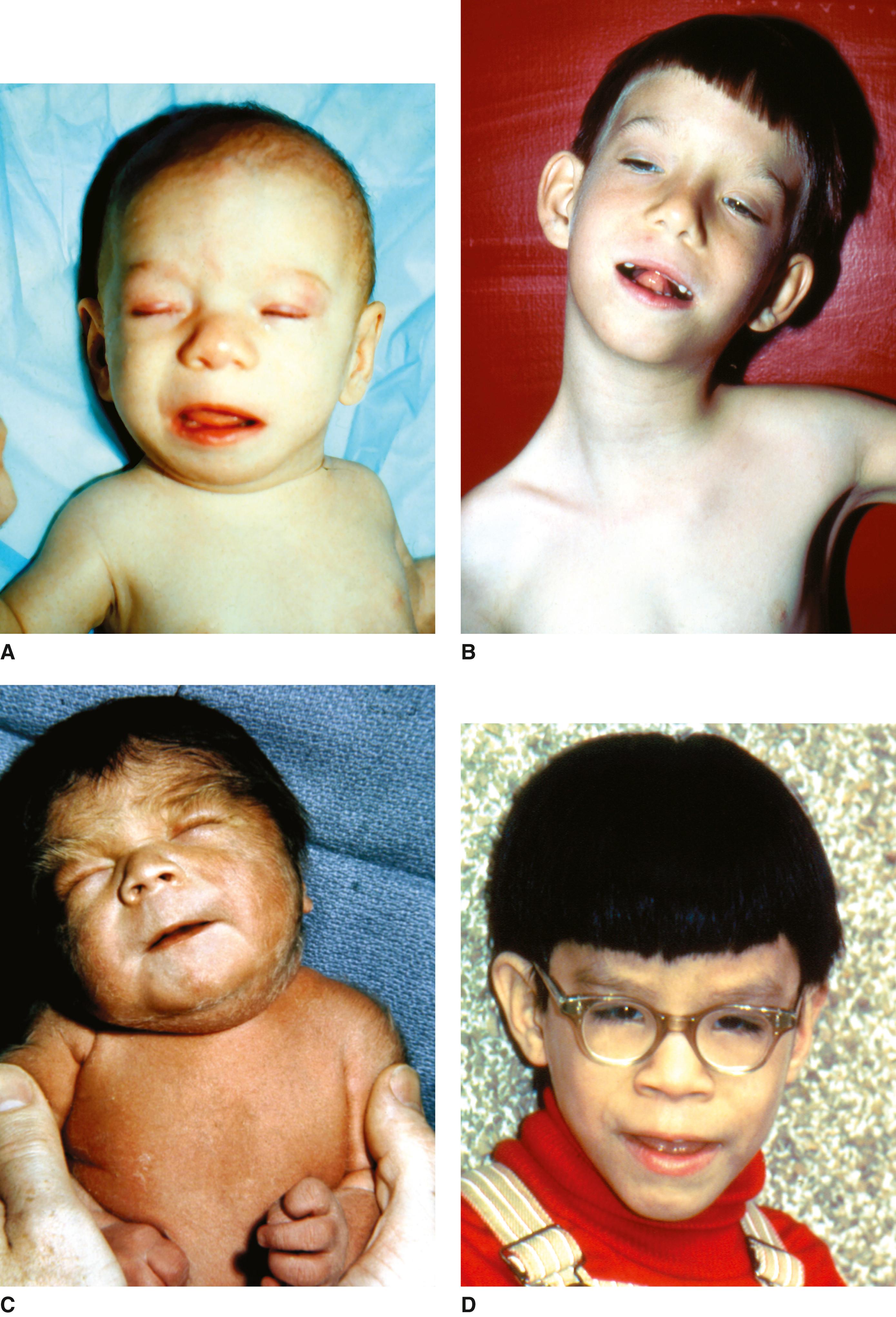
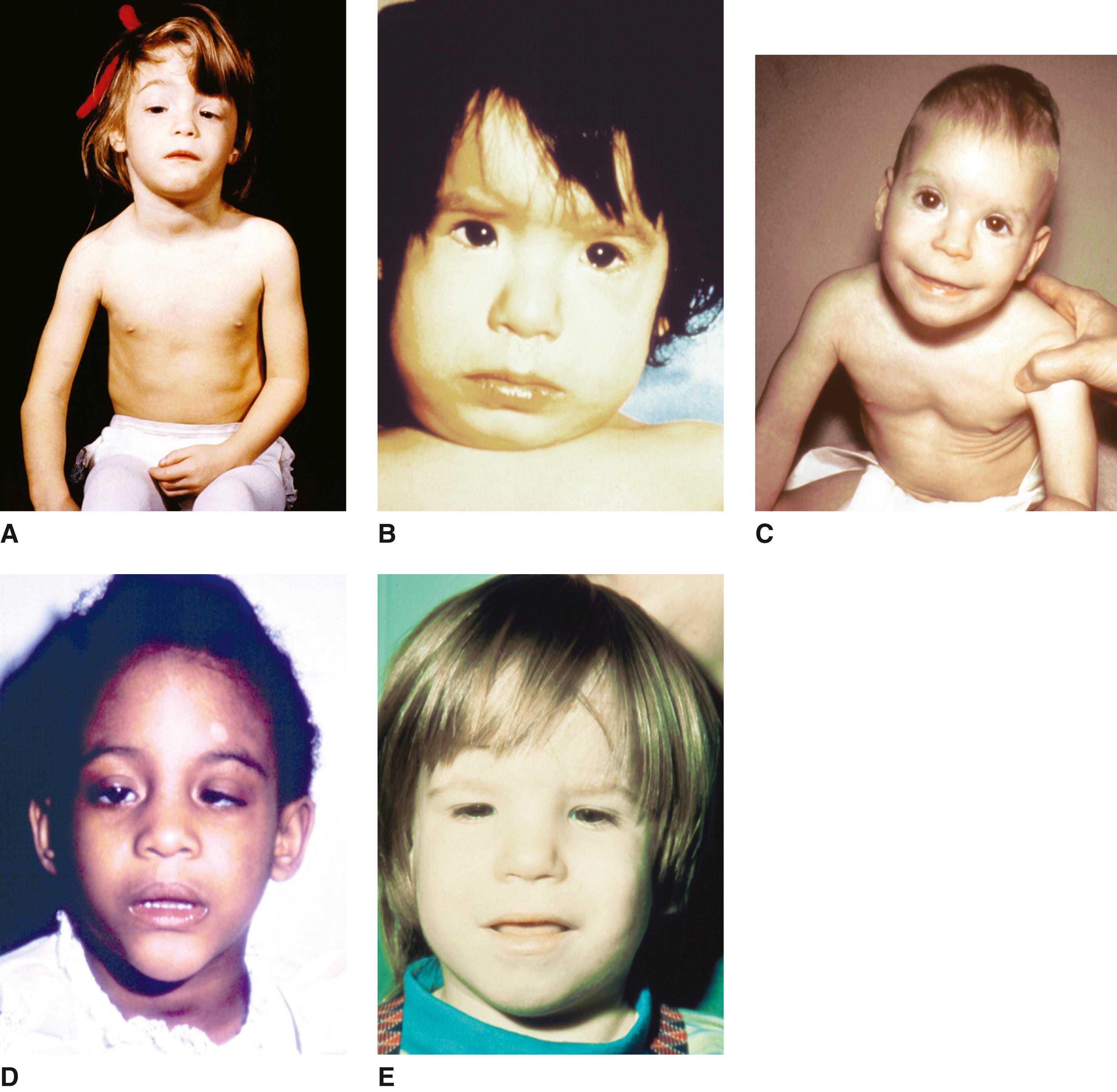
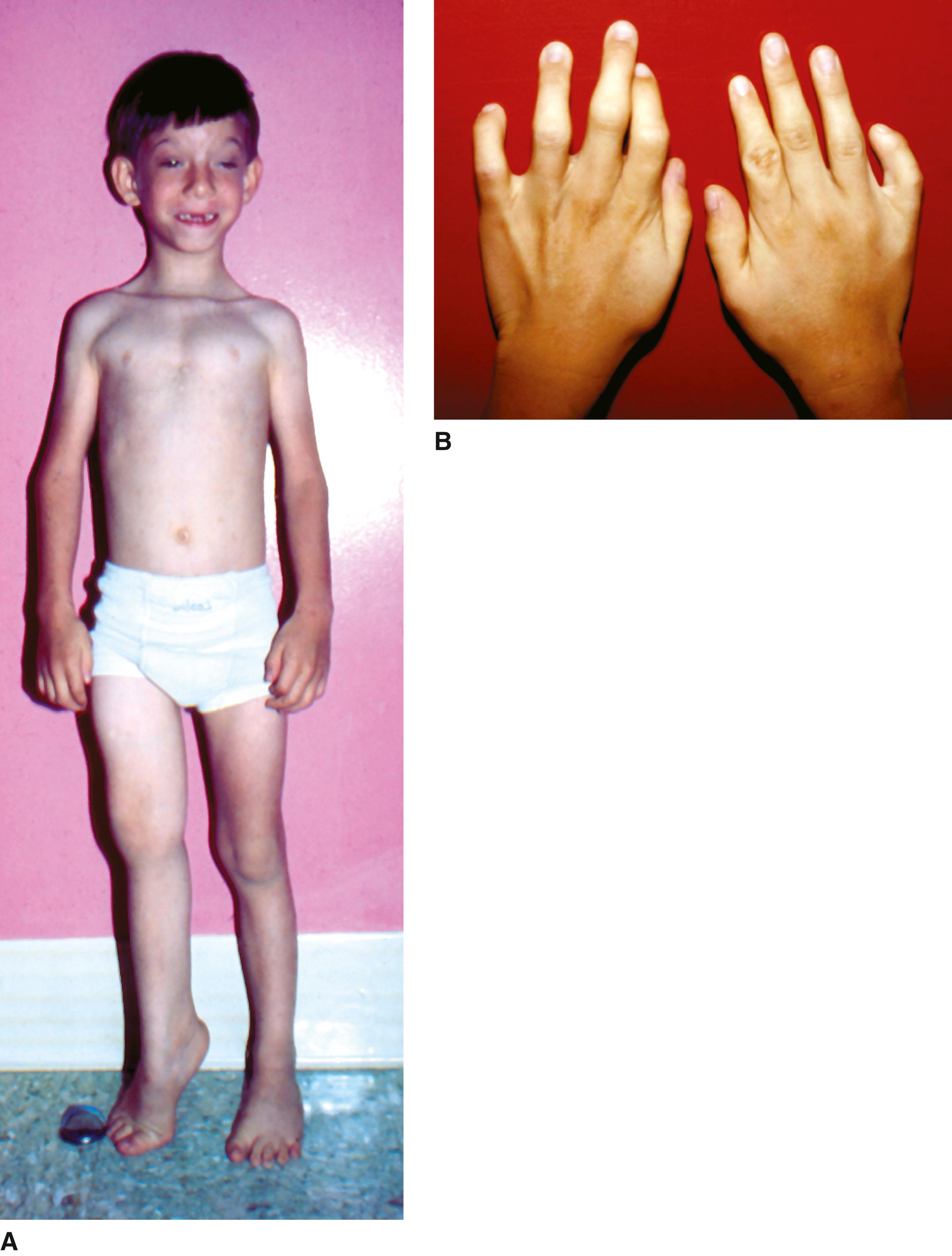
Although data suggesting the possible teratogenic effects of anticonvulsants were first presented by Meadow in 1968, convincing epidemiologic evidence of the association between hydantoins and congenital abnormalities awaited the studies of Fedrick and of Monson and colleagues. Further studies by Speidel and Meadow and by Hill and colleagues revealed a pattern of malformation that may include digit and nail hypoplasia, unusual facies, and growth and intellectual disabilities.
Growth. Mild-to-moderate growth deficiency, usually of prenatal onset, but may be
accentuated in the early postnatal months.
Performance. Occasional borderline to mild intellectual disability; performance in childhood may be better than that anticipated from progress in early infancy.
Craniofacial. Wide anterior fontanel; metopic ridging; ocular hypertelorism; broad, depressed nasal bridge; short nose with bowed upper lip; broad alveolar ridge; cleft lip and palate.
Limbs. Stiff, tapered fingers; hypoplasia of distal phalanges with small nails, especially postaxial digits; low-arch dermal ridge patterning of hypoplastic fingertips; digitalized thumb; shortened distal phalanges and metacarpals and cone-shaped epiphyses; dislocation of hip.
Other. Short neck, rib anomalies, widely spaced small nipples, umbilical and inguinal hernias, pilonidal sinus, coarse profuse scalp hair, hirsutism, low-set hairline, abnormal palmar crease, strabismus.
Microcephaly, brachycephaly, positional foot deformities, strabismus, coloboma, ptosis, slanted palpebral fissures, webbed neck, pulmonary or aortic valvular stenosis, coarctation of aorta, patent ductus arteriosus, cardiac septal defects, single umbilical artery, pyloric stenosis, duodenal atresia, anal atresia, renal malformation, hypospadias, micropenis, ambiguous genitalia, cryptorchidism, symphalangism, syndactyly, terminal transverse limb defect, cleft hand, holoprosencephaly.
It is not uncommon for infants to have relative failure to thrive during the early months; the reasons for this are unknown. IQ has been within the normal range. In a group of 48 three-year-olds who had been prenatally exposed to hydantoin, mean IQ was 99 with a range from 94 to 104. In another study conducted on prenatally exposed 6-year-olds, mean IQ was 108.Verbal abilities were lower than nonverbal abilities. However, no dose-response effect was noted.
The cause of this disorder is prenatal exposure to phenytoin (Dilantin) or one of its metabolites. The risk of a hydantoin-exposed fetus having fetal hydantoin syndrome is approximately 10%. No dose-response curve has been demonstrated, and no “safe” dose has been found below which there is no increased teratogenic risk.
Similar craniofacial features referred to as the “anticonvulsant facies” are associated with prenatal exposure to carbamazepine, hydantoin, primidone, and phenobarbital. In addition, an increased risk for meningomyelocele has been associated with prenatal exposure to carbamazepine; an increased risk for oral clefts has been associated with prenatal exposure to hydantoins and carbamazepine; and an increased risk for congenital cardiac defects has been associated with prenatal exposure to phenobarbital and carbamazepine. Good evidence indicates that exposure to a combination of the anticonvulsants (polytherapy) may increase the risk to the fetus. It has been suggested that the teratogenicity of these agents is associated with cardiac rhythm disturbances secondary to their propensity to inhibit a specific ion current (IKr) and subsequent hypoxic damage. IKr is critical for embryonic cardiac repolarization and rhythm regulation. Studies in early mouse embryo culture suggest a greater risk exists for malformation in association with polytherapy than monotherapy and that the risk is linked to disturbances in cardiac rhythm.
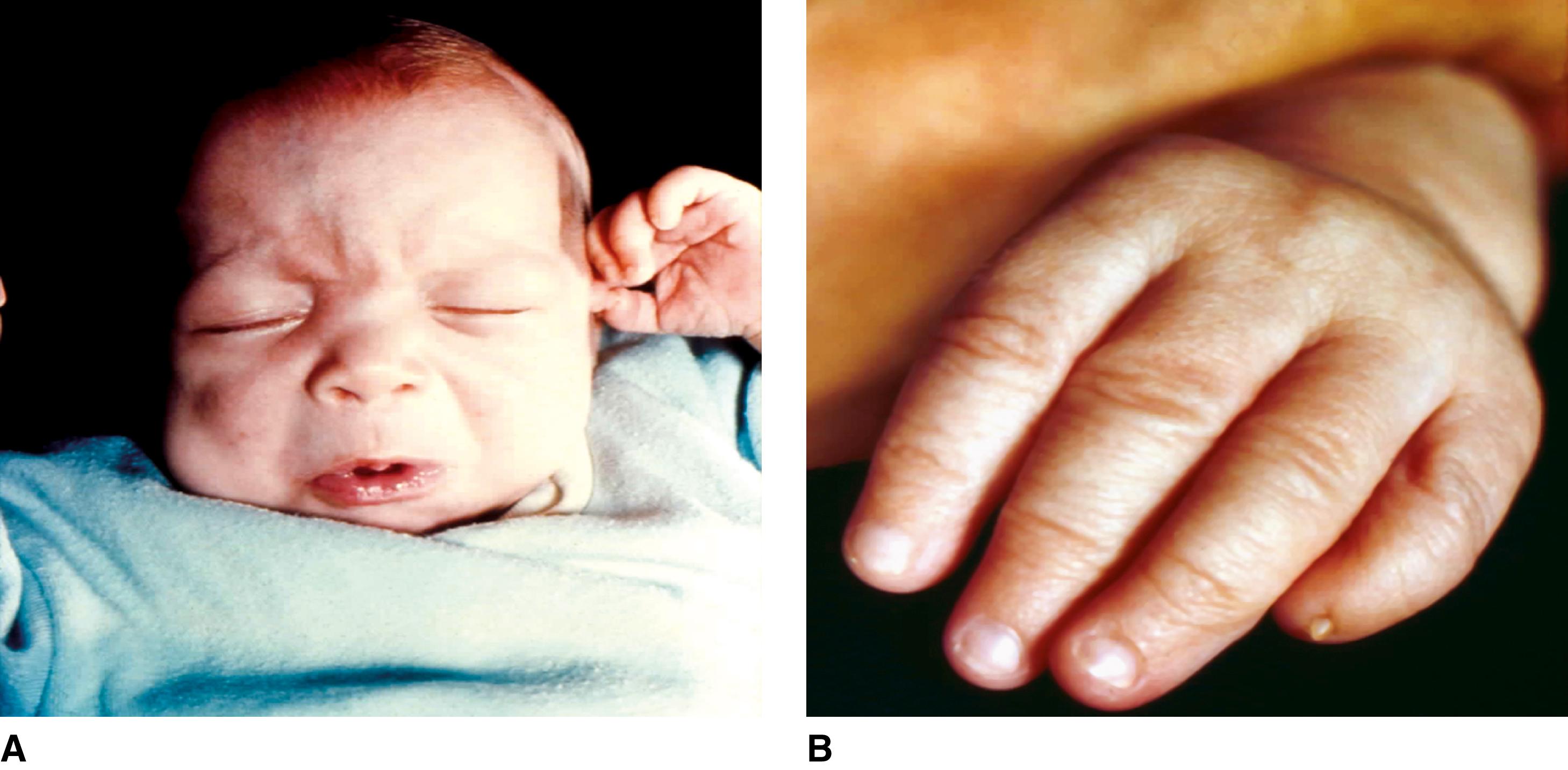
Concern was raised regarding prenatal valproic acid exposure in 1982 by Robert and Guiband, who documented an association between maternal ingestion of valproic acid and meningomyelocele in the offspring. DiLiberti and colleagues and Hanson and colleagues set forth a broader pattern of malformation in 1984.
Performance. Delayed development. At 3 years of age, poor cognitive development; verbal abilities lower than nonverbal abilities.
Craniofacial. Narrow bifrontal diameter; metopic ridging; larger cephalic index (disproportionate increased width of the skull relative to a shortened anterior-posterior length); high forehead; epicanthal folds connecting with an infraorbital crease or groove; ocular hypertelorism; broad, low nasal bridge with short nose and anteverted nostrils; midface hypoplasia; long smooth philtrum with a thin vermilion border; relatively small mouth; micrognathia.
Cardiovascular. Aortic coarctation, hypoplastic left heart, aortic valve stenosis, interrupted aortic arch, secundum type atrial septal defect, pulmonary atresia without ventricular septal defect, perimembranous ventricular septal defect.
Limbs. Long, thin fingers and toes; joint laxity; hyperconvex fingernails; talipes equinovarus.
Growth delay, neural tube closure defects, autism spectrum disorder, brain atrophy, cyst of septum pellucidum, septooptic dysplasia, esotropia, nystagmus, tear duct anomalies, microphthalmia, iris defects, cataracts, corneal opacities, cleft palate, hearing loss, supernumerary nipples, hemangiomas, pigmentary abnormalities, hypospadias, inguinal and umbilical hernias, omphalocele, broad chest, bifid rib, postaxial polydactyly, radial ray defects, nail hypoplasia, preaxial defects of feet, triphalangeal thumbs, tracheomalacia, lung hypoplasia, laryngeal hypoplasia, renal hypoplasia, abnormal collecting system, hydronephrosis, hypospadias, poor bladder control.
Increasing concern exists regarding the long-term cognitive effects of prenatal valproate exposure. A significant performance decline in motor functioning, adaptive functioning (as measured by parental ratings), and social skills, as well as an increased risk for attention-deficit disorders, has been documented. Behavioral problems are common, and many of the affected children require educational support. Impairments vary based on age. Cognitive, speech, and motor development problems are common in infancy, and IQ, language, memory, attention problems, and difficulties in executive function are more problematic at school age and beyond. Monotherapy with valproate has been associated with significantly more neurodevelopmental/behavioral problems than monotherapy with other antiepileptic drugs. Polytherapy that includes valproate is associated with significantly lower cognitive abilities and greater risk for structural malformations. Cognitive and neuropsychological deficits often occur without all or even any of the physical features.
The cause of this disorder is prenatal valproic acid exposure.
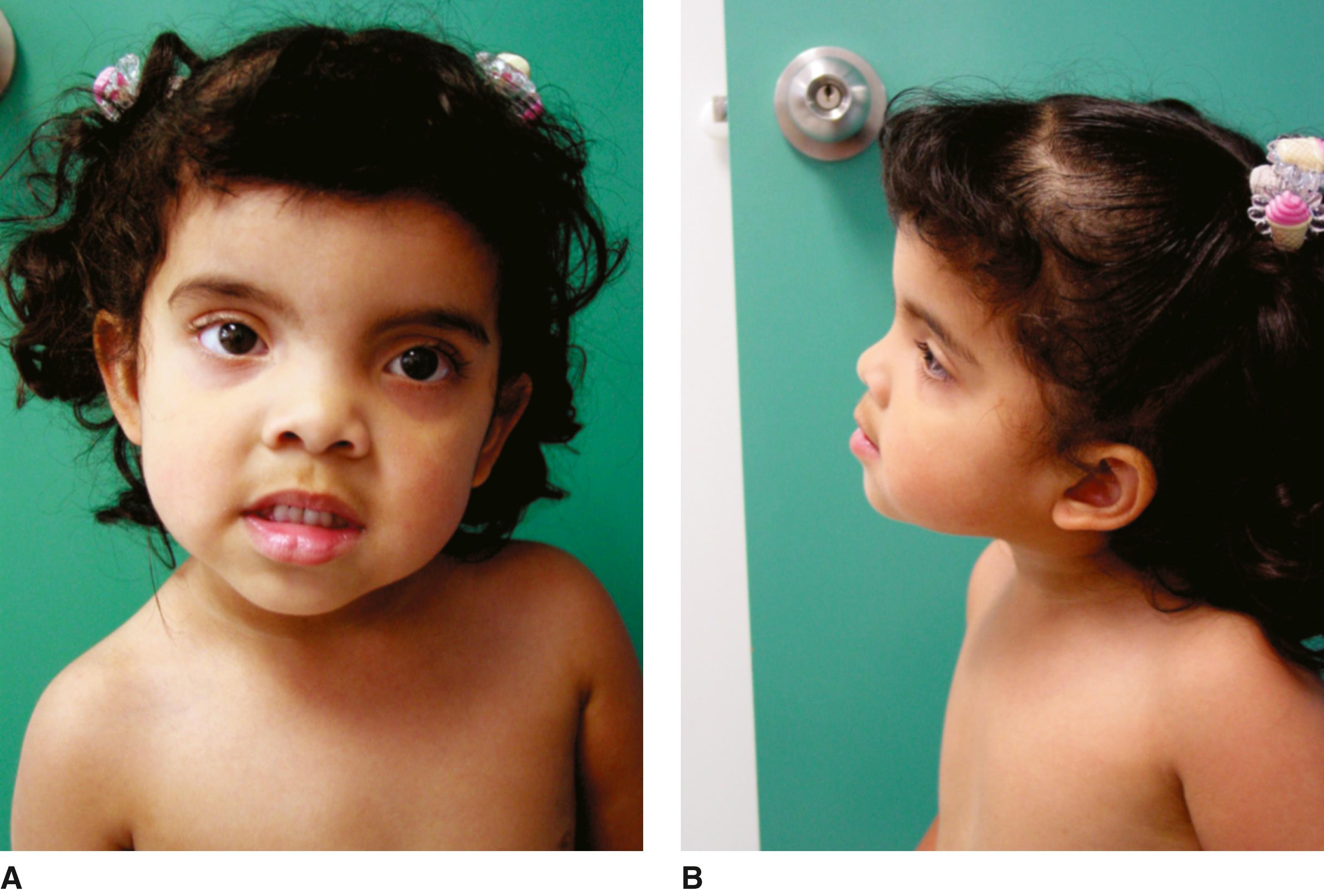
Isolated reports of infants who, in retrospect, were affected by warfarin were followed in 1975 by simultaneous recognition of this association in five infants. A number of infants are known to have been affected.
Facies. Nasal hypoplasia and depressed nasal bridge, often with a deep groove between the alae nasi and nasal tip.
Skeletal. Stippling of uncalcified epiphyses, particularly of axial skeleton (vertebrae and pelvis), at the proximal femora and in the calcanei; stippling disappears after the first year.
Limbs. Hypoplastic distal phalanges shaped like inverted triangles with the apices pointing proximally.
Growth. Low birthweight; most demonstrate catch-up growth.
Become a Clinical Tree membership for Full access and enjoy Unlimited articles
If you are a member. Log in here